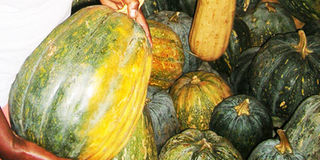Hidden wealth in pumpkins

Pumpkins are sold each between Shs500 and Shs3,000 depending on the size. Photo by Joseph Miti
What you need to know:
Mr Henry Kasozi owns a market along Mityana-Mubende Highway and it’s here that you find farmers and traders either buying pumpkins, seeking counsel or in search of financial services.
Pumpkins are nutritious, help ease a number of infections and can be sold to supplement income, writes Joseph Miti.
Mr Henry Kasozi owns a market along Mityana-Mubende Highway and it’s here that you find farmers and traders either buying pumpkins, seeking counsel or in search of financial services.
Kasozi is the chairman of Nkokonjeru Women Saving and Credit Project, a community-based organisation that comprises women, youths and men who make several products out of pumpkins. He has been growing pumpkins for many years and adding value to the less mentioned crop in food security campaigns, which has made him popular in Mityana District.
Besides growing the crop for food, he has identified other benefits such as extracting wine as well as producing animal and bird feeds from pumpkins. “The idea to grow pumpkins was born out of the realisation that they take few months to grow and serve several purposes. They can serve as food, sauce, animal feeds and medicine among others,” he says.
“Pumpkins are a renowned nutritious food recommended for reducing inflammation of the prostate, digestion disorders and stomach acidity with ease. Young pumpkins are effective in de-worming children and also help in fighting malnutrition,” Kasozi, who acquired the knowledge from his father, a teacher who loved to grow yams and pumpkins, says.
Profitable
He started off as a subsistence farmer before graduating to a commercial farmer in 2002. Nowadays, he grows pumpkins on a large scale where he harvests between 2,000 to 2,500 pumpkins per acre. He sells each pumpkin at between Shs500 to Shs3,000 depending on the size at farm gate price.
This means he can earn between Shs1million and Shs6million per acre per season. Pumpkins have three seasons a year. He also sells pumpkin seeds at Shs1,000 a sachet. Kasozi recalls that when he went commercial, he received a bumper harvest within months, ‘forcing’ him to construct a market. He then mobilised other farmers to grow pumpkins to supply the market. But the majority lacked start-up funds, which led the farmers to form Nkokonjeru Women Saving and Credit Project (NWSCP) to offer financial support. Bringing more farmers on board boosted production, which exceeded demand in a short time. Surplus production later discouraged some farmers.
“While thinking of what to do, a friend who had just returned from abroad approached me and advised me on how to add value to our produce,” Kasozi recalls. “He told me we could produce many items including wine from pumpkins. In fact he produced the first wine for us,” Kasozi said as he opened a cupboard to pick a bottle of wine labeled Farmland Pumpkin Wine he serves his guests. He also picked a sachet of roasted pumpkin seeds ready for eating.
Quick returns
Basing on the benefits of the crop, the farmer says pumpkin growing is the best enterprise for starters who want quick and easy introduction to crop farming, adding that farmers who venture into pumpkin growing get returns within days after planting. As soon as the crop starts to trail, a farmer starts earning from leaves he/she can pick and sell as greens.
At times, the leaves can be dried and pounded to form a powder which is normally sold as medicine or flavour, the chairman explains. Ms Jane Nakivumbi, the treasurer of NWSCP, says pumpkins take three to four months to grow, can grow on all Uganda’s soils and require minimal labour since they don’t require weeding. A pumpkin can also stay eight to 12 months after harvest before it goes bad. This makes it more dependable during times of food scarcity. “Pumpkins have the potential to boost food security and eradicate poverty in the country and so the government should promote them under the Prosperity for All (Bonna-bagagawale) programme,” Ms Nakivumbi says. Kasozi’s skills have not gone unrecognised.
Often, he’s hired by NGOs, CBOs and Mityana District to teach farmers how to grow pumpkins. The district has also adopted pumpkins as one of the major crops farmers have to grow to fight poverty and increase food production.
Today, Kasozi dreams of making pumpkin flour, which he says the group would use to make bread, chapattis and biscuits among other things. “We are in the process of inviting scientists from Makerere University Department of Food Science to assist in determining the moisture content required when drying pumpkins in order to produce good flour,” he says.
However, though the group has made advancements in pumpkin growing, they still lack support in terms of funds, machinery and technology. For instance, they extract wine from pumpkins using hands and a couple of basic grinding tools. Lack of capital has limited the group’s progress and their ability to produce better quality and quantity as they would want. “We request the government to support us with the necessary equipment, send us scientists to provide technical support as well as financial assistant to support the organisation,” Mr Kasozi appeals. With that assistance, they can only get better.




